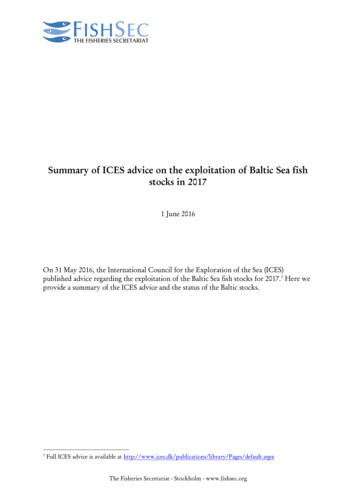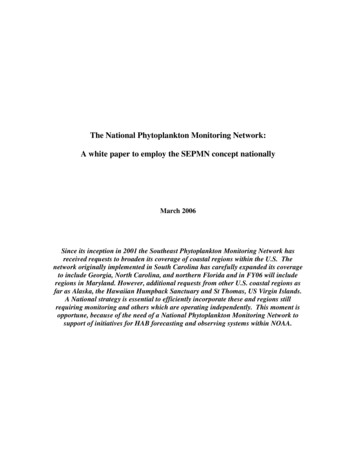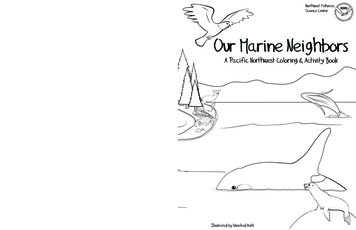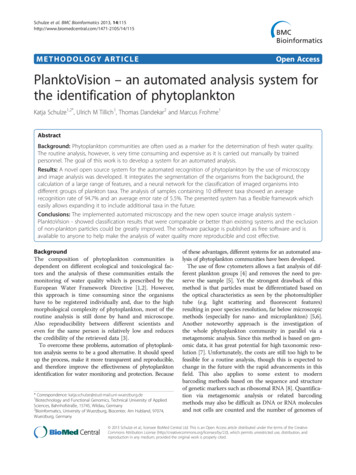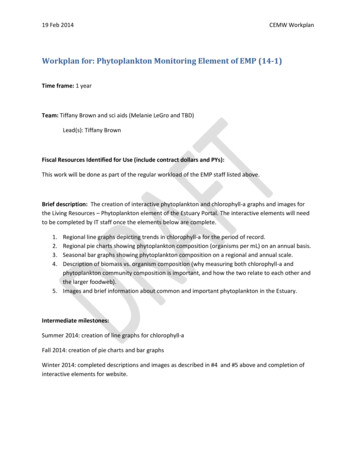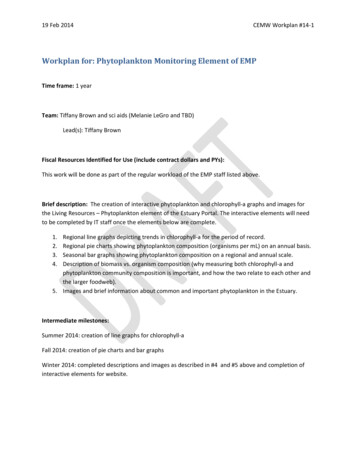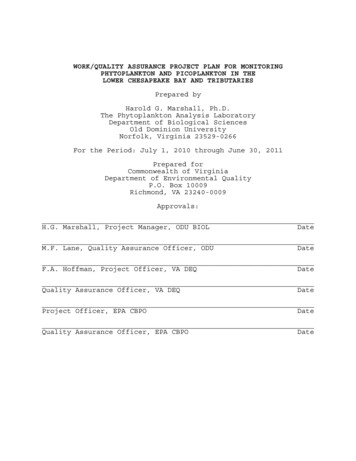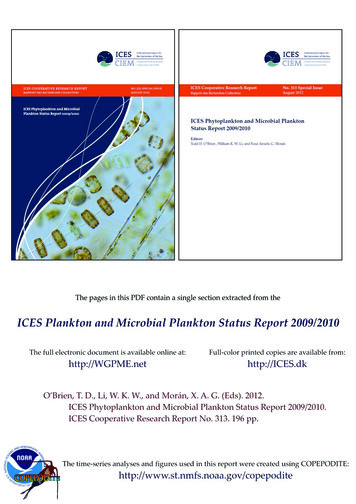
Transcription
ICES Phytoplankton and Microbial Plankton Status Report 2009/20106.5 English Channel REPHY sites (Sites 34–35)Dominique Soudant (primary contact) and Alain LefebvreFigure 6.5.1Locations of the REPHY EnglishChannel plankton monitoringarea (Sites 34–35), plotted ona map of average ronmentalsummary plots (see Section2.2.1).The French Phytoplankton and PhycotoxinMonitoring Network (REPHY) was set up in 1984with three objectives: to enhance knowledge ofphytoplankton communities, to safeguard publichealth, and to protect the marine environment(Belin, 1998). Phytoplankton along the French coasthas been sampled up to twice a month since 1987 at12 coastal laboratories. For that purpose, the French82/83
ICES Cooperative Research Report No. 313coast is divided into a hierarchy of sites and subsitescommon to three regional networks: the EnglishChannel, the Bay of Biscay, and the MediterraneanSea.Within the English Channel, the REPHY Point 1SRN Boulogne and At So sites are both shallow andcharacterized by a macrotidal regime, especiallythe latter, which is also more sheltered. Samplingstarted in 1987 at At So and five years later atPoint 1 SRN Boulogne. Ancillary measurementsof temperature, salinity, chlorophyll a andphaeopigments, inorganic nutrients concentrations,and turbidity are also routinely measured (usually15 samples per year). Oxygen was incorporated in2007 at both sites.Seasonal and interannual trends (Figures 6.5.2,6.5.3)Seasonal cycles of chlorophyll as a measure of totalphytoplankton biomass are clearly unimodal at bothsites, with maxima in April. Chlorophyll values areca. 50% greater at At So, but peak values at both sitesgenerally exceed 10 µg l–1. Diatom seasonal cyclesat both sites featured a summer high and a winterlow. Maximum values at Point 1 SRN Boulogne areusually observed in August after exhibiting relativelyhigh values from March onwards, and then declinesharply until reaching minimum values in lateautumn. In contrast, the seasonal maximum at AtSo was earlier in the year (June), with a smootherdecline. The seasonal cycle of dinoflagellates at bothsites was characterized by maxima in July–Augustand minima in December–February. A secondarypeak in May was also observed at Point 1 SRNBoulogne. The diatoms:diatoms dinoflagellatesratio covaries at both sites, with marked minima inAugust. Dominant taxa include Chaetoceros socialis,Guinardia delicatula, and various species of Pseudonitzschia among the diatoms and noflagellates. Phaeocystis globosa is also abundant,especially during the first half of the year.Increasing salinity has been observed for bothtime-series, along with significant featured strong increases at both sites (p 0.01),corresponding to strong decreases in thediatoms:diatoms dinoflagellates ratio at both sites.Diatoms were increasing (non-significant) at thePoint 1 SRN site, whereas no apparent trend wasfound in At So.
ICES Phytoplankton and Microbial Plankton Status Report 2009/2010Figure .2)showing the seasonal at the REPHY Point 1 SRNBoulogne plankton monitoringsite. Additional variables fromthis site are available online athttp://wgpme.net/time-series.84/85
ICES Cooperative Research Report No. 313Figure 6.5.3Multiple-variablecomparisonplot (see Section 2.2.2) showingthe seasonal and interannualproperties of select cosampledvariables at the REPHY AtSo plankton monitoring site.Additional variables from thissite are available online athttp://wgpme.net/time-series.
ICES Phytoplankton and Microbial Plankton Status Report 2009/20108.1 Bay of Biscay REPHY sites (Sites 46-49)Dominique Soudant (primary contact), Myriam Perrière Rumèbe, and Danièle MaurerFigure 8.1.1Locations of the REPHY Bay ofBiscay plankton monitoring areas(Sites 46–49), plotted on a map ofaverage chlorophyll concentration,and their corresponding environmental summary plots (seeSection 2.2.1).The French Phytoplankton and PhycotoxinMonitoring Network (REPHY) was set up in 1984with three objectives: to enhance knowledge ofphytoplankton communities, to safeguard publichealth, and to protect the marine environment(Belin, 1998). Phytoplankton along the French coasthas been sampled up to twice a month since 1987at twelve coastal laboratories. The French coastis divided into a hierarchy of sites and subsitescommon to three regional networks: the EnglishChannel, the Bay of Biscay, and the MediterraneanSea. Men er Roue, Ouest Loscolo, Le Cornard, andTeychan Bis are four REPHY sites in the Bay of Biscay.These sites are all shallow, meso- to macrotidal, withdiffering wave exposure from sheltered in TeychanBis to moderately exposed at Ouest Loscolo and LeCornard.From 1987 onwards, the basic environmentalvariables salinity, temperature, and turbidity aremeasured together with phytoplankton compositionand abundance. Variables such as inorganic nutrientconcentrations chlorophyll a, pheopigments, andoxygen were included in the time-series of most ofthe sites later in different years.Seasonal and interannual trends (Figure 8.1.2–8.1.5)Seasonal cycles of chlorophyll as a measure oftotal phytoplankton biomass are bimodal at Mener Roue (Figure 8.1.2), Ouest Loscolo (Figure8.1.3), and Teychan Bis (Figure 8.1.5), with maximagenerally found in May/June and September/October, which, at the latter site, are even of greatermagnitude than the spring peak, and unimodal116/117
ICES Cooperative Research Report No. 313at Le Cornard (Figure 8.1.4), with an annualmaximum in June. Although dinoflagellates at thesites usually exhibited unimodal cycles, peakingaround August, the Teychan Bis site was bimodal,with a strong May peak followed by a weakerAugust increase. Diatoms at Men er Roue, OuestLoscolo, and Le Cornard were bimodal, with peaksin May/June and September/October in accordancewith chlorophyll cycles. Diatoms at Le Cornardwere unimodal, with a strong peak in March anda slow, steady decrease onwards. Dominant diatomspecies common to all sites include Skeletonemacostatum and Leptocylindrus minimus, with L.danicus important at Ouest Loscolo and TeychanBis. Asterionellopsis glacialis may be frequent inblooms at Teychan Bis year-round. Pseudo-nitzschiasp. blooms appeared more frequently in the lasttwo years. Dinoflagellates include several speciesFigure 8.1.2Multiple-variablecomparisonplot (see Section 2.2.2) showingthe seasonal and interannualproperties of select cosampledvariables at the Men er Roueplanktonmonitoringsite.Additional variables from thissite are available online athttp://wgpme.net/time-series.of Prorocentrum and Protoperidinium. Lepidodiumchlorophorum may form summer blooms locally.Long-term trends for in situ temperature, salinity,and chlorophyll are not significant at any of the Bayof Biscay REPHY sites. However, some significanttendencies have been identified in the largephytoplankton groups. Total diatom abundancehas increased significantly at the Ouest Loscolo(p 0.05) and Le Cornard (p 0.01) sites. Totaldinoflagellate abundance has also increased at bothsites, but only Le Cornard’s trend was significant(p 0.05). At the Men er Roue and Teychan Bissites, diatoms and dinoflagellate totals were bothdecreasing (but without statistical significance).The diatoms:diatoms dinoflagellates ratio wasdecreasing at the Teychan Bis site (p 0.05) and atthe Ouest Loscolo site (non-significant).
ICES Phytoplankton and Microbial Plankton Status Report 2009/2010Figure 8.1.3Multiple-variablecomparisonplot (see Section 2.2.2) showingthe seasonal and interannualproperties of select cosampledvariables at the Ouest Loscoloplanktonmonitoringsite.Additional variables from thissite are available online athttp://wgpme.net/time-series.118/119
ICES Cooperative Research Report No. 313Figure 8.1.4Multiple-variablecomparisonplot (see Section 2.2.2) showingthe seasonal and interannualproperties of select cosampledvariables at the Le Cornardplanktonmonitoringsite.Additional variables from thissite are available online athttp://wgpme.net/time-series.
ICES Phytoplankton and Microbial Plankton Status Report 2009/2010Figure 8.1.5Multiple-variablecomparisonplot (see Section 2.2.2) showingthe seasonal and interannualproperties of select cosampledvariables at the Teychan Bisplanktonmonitoringsite.Additional variables from thissite are available online athttp://wgpme.net/time-series.120/121
ICES Phytoplankton and Microbial Plankton Status Report 2009/20109.3 Mediterranean REPHY sites (Sites 57–58)Dominique SoudantFigure 9.3.1Locations of the REPHYMediterranean Sea planktonmonitoring areas (Sites 57–58),plotted on a map of averagechlorophyll concentration, andtheir corresponding environmental summary plots (seeSection 2.2.1).The French Phytoplankton and PhycotoxinMonitoring Network (REPHY) was set up in 1984with three objectives: to enhance knowledge ofphytoplankton communities, to safeguard publichealth, and to protect the marine environment(Belin, 1998). Phytoplankton along the French coasthas been sampled up to twice a month since 1987at twelve coastal laboratories. For that purpose,the French coast is divided into a hierarchy of sitesand subsites common to three regional networks:the English Channel, the Bay of Biscay, and theMediterranean Sea. Lazaret A and Diana Centre(Figure 9.3.1) are two Mediterranean REPY sites.Lazaret A is located in well-mixed waters, with amedium-depth, sandy bottom within Toulon Bay.Diana Center is located in shallow, less-mixedwaters of a coastal lagoon in Corse and features amuddy bottom.As with the Bay of Biscay and English ChannelREPHY sites, sampling started in 1987, withsalinity, temperature, turbidity, and oxygenmeasured concomitantly from the beginningor one year thereafter. Chlorophyll a andpheopigments started at Diana Centre in 1988and at Lazaret A in 1999. This latter site issampled twice a month on average, whereas fewersamples (17 on average from 10 months) are takenannually at Diana Centre.144/145
ICES Cooperative Research Report No. 313Seasonal and interannual trends (Figures 9.3.2–9.3.3)Chorophyll annual cycles show maximum valuesin late winter at both sites, but equally high valuesare also observed in late summer at Diana Centre.At this latter site, chlorophyll values are well above1 µg l–1 for most of the year, whereas chlorophyllremains below this value through the year atLazaret A. Diatom abundance tends to fluctuateyear-round, exhibiting maxima in late summer(September) at both sites, with relatively highvalues also in February (Lazaret A) and December(Diana Centre). Dinoflagellates peaked early inthe year (winter–spring) at Lazaret A, whereasthose at Diana Centre peaked in October andDecember. Diatoms include Chaetoceros at bothsites, with species such as Skeletonema costatum andFigure 9.3.2Multiple-variablecomparisonplot (see Section 2.2.2) showingthe seasonal and interannualproperties of select cosampledvariables at the REPHY LazaretA plankton monitoring site.Additional variables from thissite are available online athttp://wgpme.net/time-series.Pseudo-nitzschia more abundant at Lazaret A andAsterionellopsis glacialis, Dactyliosolen fragilissimus,and Hemiaulus sp. at Diana Centre. Common generaof dominant dinoflagellates are Prorocentrum,Bysmatrum, Scrippsiella, and Ensiculifera, althoughspecies may be different at both sites.Salinity has been steadily increasing for morethan two decades at both Mediterranean REPHYsites. A significant (p 0.05) increase in totalphytoplankton (as chlorophyll) is observed atLazaret A, probably owing to a concomitantsignificant (p 0.01) increase in diatom abundance,whereas a long-term decrease in dinoflagellateabundance was conspicuous (p 0.01) at bothsites. Consequently, a significant increase in thediatoms:diatoms dinoflagellates ratio was observedat both sites, more marked at Lazaret A.
ICES Phytoplankton and Microbial Plankton Status Report 2009/2010Figure 9.3.3Multiple-variablecomparisonplot (see Section 2.2.2) showingthe seasonal and interannualproperties of select cosampledvariables at the REPHY DianaCentre plankton monitoringsite. Additional variables fromthis site are available online athttp://wgpme.net/time-series.146/147
The French Phytoplankton and Phycotoxin Monitoring Network (REPHY) was set up in 1984 with three objectives: to enhance knowledge of phytoplankton communities, to safeguard public health, and to protect the marine environment (Belin, 1998). Phytoplankton along the French coast has been sampled up to twice a month since 1987

